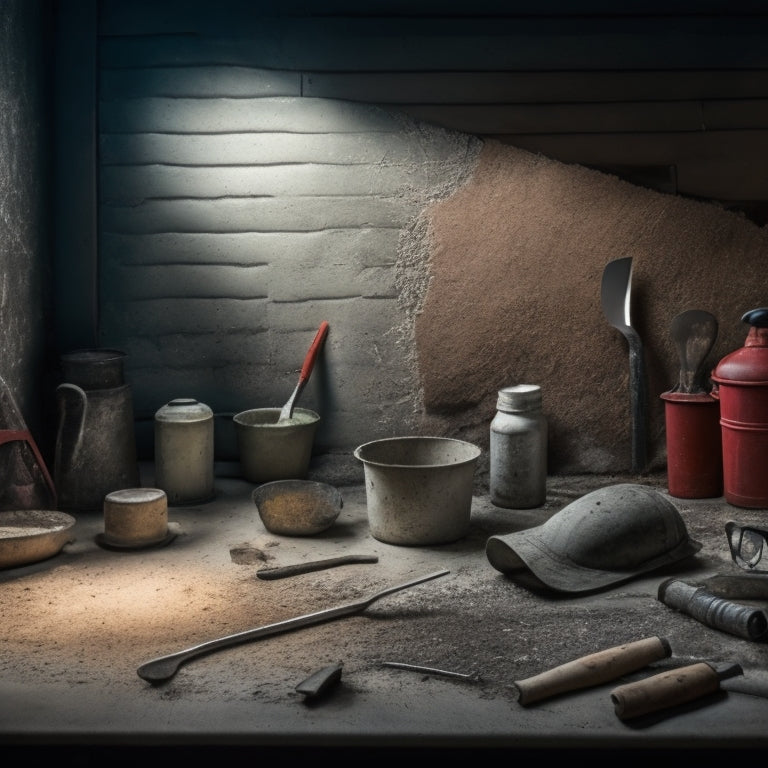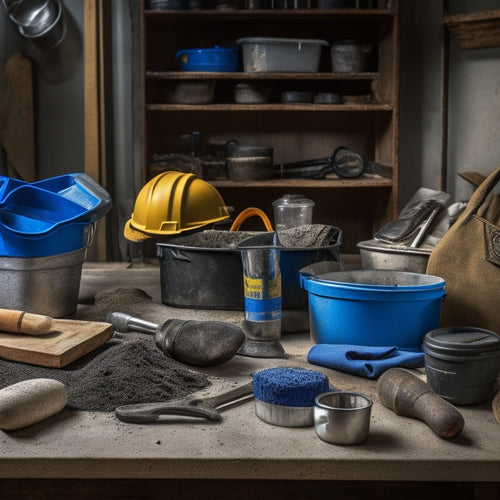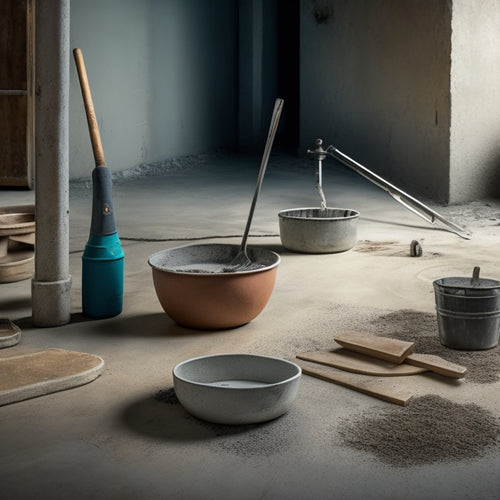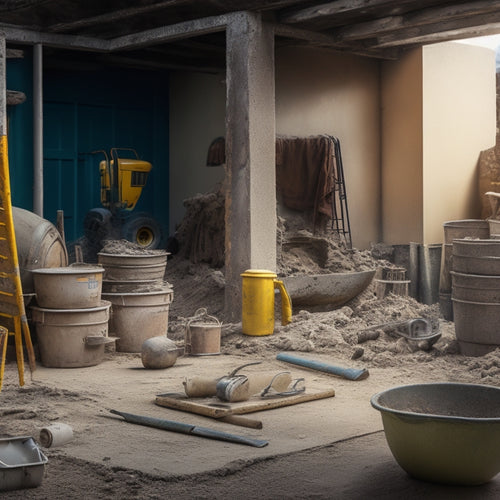
3 Best Tools for Repairing Concrete Walls
Share
You'll need three essential tools to effectively repair your concrete walls: a wire brush to scrape away dirt and grime, a putty knife to apply patching compound with precision, and a trowel to smooth and feather the repair for a seamless finish. These tools will help you prepare, patch, and finish your concrete wall repairs. With the right preparation, application, and finishing techniques, you'll achieve a strong and durable repair. By mastering these fundamental tools, you'll be well on your way to tackling more complex repairs and producing professional-looking results.
Key Takeaways
• A wire brush is essential for removing dirt, grime, and old adhesive from the concrete surface before repair.
• Safety goggles and a dust mask are crucial for protecting yourself from debris and harmful particles during the repair process.
• A hammer, chisel, and scraper are necessary for aggressive surface preparation, ensuring a strong bond for the repair.
• A putty knife is required for even and smooth application of patching compound, and a trowel aids in smoothing the surface and feathering edges.
• Quality tools ensure effective cleaning and strong bonding for durable and long-lasting concrete wall repairs.
Essential Tools for Preparation
Before you begin repairing a concrete wall, gather essential tools for preparation, including a wire brush, safety goggles, and a dust mask, to guarantee a clean and safe working environment. Proper surface preparation is vital for a successful repair, and having the right tools is key.
You'll need a wire brush to remove dirt, grime, and old adhesive from the damaged area. This will assure a strong bond between the old concrete and the new repair material.
When it comes to tool selection, don't skimp on quality. Invest in a sturdy wire brush with stiff bristles that can withstand the rigors of scrubbing concrete. Safety goggles will protect your eyes from debris, while a dust mask will prevent inhalation of harmful particles.
Additionally, consider a hammer, chisel, and scraper for more aggressive surface preparation. By having these essential tools at your disposal, you'll be well-prepared to tackle the repair job with confidence and precision.
Repair and Patching Essentials
With your surface properly prepared, you'll need to assemble a set of repair and patching essentials, including a concrete patching compound, a putty knife, and a trowel, to effectively fill and finish the damaged area.
The patching compound should be suitable for the type of repair you're doing, whether it's a hairline crack or a larger hole. When choosing a compound, consider factors like drying time, color, and texture to guarantee a seamless blend with the surrounding concrete.
Using the putty knife, apply the patching compound to the damaged area, spreading it evenly and smoothly. For larger repairs, you may need to apply multiple layers, allowing each layer to dry before applying the next.
The trowel comes in handy for smoothing out the surface and feathering the edges of the repair. As you work, use various repair techniques, such as pressing the compound firmly into the crack or hole, to guarantee a strong bond.
Finishing Touches and Cleanup
You'll now need to focus on applying a finishing coat to the repaired area to guarantee a uniform appearance and seal out moisture. This involves using specialized tools to achieve a smooth, even finish.
Utilize a trowel or putty knife to apply a thin layer of finishing compound to the repaired area, feathering it out towards the edges to blend with the surrounding concrete. Employ smoothing techniques, such as using a steel trowel or a foam float, to remove any excess material and achieve a uniform texture.
Once the finishing compound has dried, you'll need to seal the surface to protect it from further damage. Apply a surface sealer using a roller or brush, following the manufacturer's instructions for application and drying times.
This will help to lock in the repairs and prevent water from seeping into the concrete. With these final touches in place, you can be confident that your concrete wall repair will last for years to come.
Frequently Asked Questions
How Long Does It Take for Concrete Repair Compound to Fully Dry?
When you apply a concrete repair compound, you're probably wondering how long it'll take to fully dry.
The drying time depends on factors like temperature, humidity, and thickness of the application. Typically, it takes anywhere from 15 minutes to an hour for the initial set, and 24 hours for a full cure.
Mastering repair techniques, like mixing and applying the compound correctly, will also impact the drying process.
Can I Use Regular Paint on a Repaired Concrete Wall?
When you're thinking of painting a repaired concrete wall, you'll need to choose the right paint type. You can't just use regular paint, as it won't adhere properly or last long.
Instead, opt for a concrete-specific paint or epoxy-based coating that's designed for masonry surfaces.
Before painting, verify proper surface preparation by cleaning the wall thoroughly and filling any pores or cracks.
This will guarantee a strong bond and a durable finish that will make you proud of your handiwork.
Are There Any Safety Precautions When Using Epoxy-Based Products?
When you commence epoxy application, it's crucial to prioritize your well-being by donning the right safety gear.
You'll want to shield yourself from potential irritants by wearing gloves, safety glasses, and a mask that filters out particles.
Additionally, guarantee good ventilation to prevent inhaling harmful fumes.
Can I Repair Concrete Walls During Extreme Weather Conditions?
When dealing with concrete repairs, you'll want to take into account the weather conditions before starting the job.
Extreme temperatures, either hot or cold, can affect the curing process and overall quality of the repair.
You'll need to make certain the surface is dry and the temperature is between 40°F and 90°F (4°C and 32°C) for best results.
If you can't control the environment, it's best to postpone the repair until the weather improves.
How Often Should I Inspect My Concrete Walls for Damage?
You should regularly inspect your concrete walls to catch potential issues before they become major problems.
Schedule routine checks, ideally every 6-12 months, to perform a thorough crack assessment and moisture inspection.
Look for signs of damage, such as hairline cracks, efflorescence, or water staining.
This proactive approach will help you identify and address minor issues, ensuring your walls remain strong and durable.
Conclusion
You've prepared, repaired, and finished your concrete wall. Now, stand back and admire your handiwork.
Your wall is stronger, smoother, and more durable than before.
You've filled cracks, patched holes, and sealed joints.
You've applied a fresh coat of finish, restoring the wall's original appearance.
With the right tools, you've transformed a damaged wall into a solid, stable structure that will last for years to come.
Related Posts
-

5 Tools Needed for Quick Fix Concrete Mixing
You'll need five essential tools to tackle a quick fix concrete mixing project efficiently. First, you'll require a s...
-

Why You Need These Concrete Overlay Tools
When tackling a concrete overlay project, you need the right tools to achieve a flawless finish and avoid costly mist...
-

What Tools Are Needed for Concrete Wall Foundations
You'll need a thorough array of tools and equipment to construct a concrete wall foundation that meets structural int...


